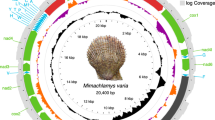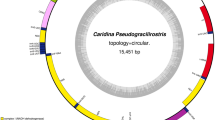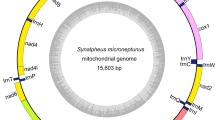Abstract
Molluscs in general and bivalves in particular, exhibit an extraordinary degree of mitochondrial gene order variation when compared with other metazoans. Here, we determined the mitochondrial genomes of two scallops Argopecten irradians and Chlamys farreri. The complete mitochondrial genome of A. irradians is 16,211 nts in length and the nearly complete mitochondrial genome of C. farreri is 20,789 nts in length. Both of the genomes contain 35 genes including 12 protein-coding genes, 2 ribosomal RNAs, and 21 transfer RNAs. In contrast to the typical animal mitochondrial genome, both of them lack one protein-coding gene atp8 and two trnSs, but show an additional copy of trnF in A. irradians and of trnM in C. farreri, respectively. Gene order and genome content were compared among the four sequenced scallops. Gene arrangement of C. farreri closely resembles that of Mizuhopecten yessoensis. However, two genomes of C. farreri and A. irradians show only three small identical gene blocks and two genomes of A. irradians and Placopecten magellanicus share only one gene block. Comparison of the gene arrangement demonstrated that the four scallops share few identical gene blocks although they belong to the same family. This feature is seldom observed in Metazoa, even in other molluscan classes. The dramatic gene rearrangement often occurs in bivalves, especially in marine bivalves. In addition, comparisons of genomic character among bivalves are also presented.




Similar content being viewed by others
Abbreviations
- cox1–3:
-
Cytochrome oxidase subunits I–III
- nad1-6, nad4L:
-
NADH dehydrogenase subunits 1–6, 4L
- atp6, atp8:
-
ATP synthase subunits 6 and 8
- cob :
-
Apocytochrome b
- rrnS, rrnL:
-
Small and large subunit ribosomal RNA
- transfer RNA (tRNA):
-
Genes designated by the one-letter code for the specified amino acid, in cases where there is more than one tRNA for a particular amino acid, they are differentiated by numeral and with anticodon
- mtDNA:
-
Mitochondrial DNA
- nts:
-
Nucleotides
References
Akasaki T, Nikaido M, Tsuchiya K, Segawa S, Hasegawa M, Okada N (2006) Extensive mitochondrial gene arrangements in coleoid Cephalopoda and their phylogenetic implications. Mol Phylogenet Evol 38:648–658
Arnason E, Rand DM (1992) Heteroplasmy of short tandem repeats in mitochondrial DNA of Atlantic cod, Gadus morhua. Genetics 132:211–220
Arndt A, Smith MJ (1998) Mitochondrial gene rearrangement in the sea cucumber genus Cucumaria. Mol Biol Evol 15:1009–1016
Benson G (1999) Tandem repeats finder: a program to analyze DNA sequences. Nucleic Acids Res 27:573–580
Boore JL (1999) Animal mitochondrial genomes. Nucleic Acids Res 27:1767–1780
Boore JL (2006) The complete sequence of the mitochondrial genome of Nautilus macromphalus (Mollusca: Cephalopoda). BMC Genomics 19:182–194
Boore JL, Brown WM (1994) The complete DNA sequence of the mitochondrial genome of the black chiton Katharina tunicata. Genetics 138:423–443
Boore JL, Medina M, Rosenberg LA (2004) Complete sequences of the highly rearranged molluscan mitochondrial genomes of the scaphopod Graptacme eborea and the bivalve Mytilus edulis. Mol Biol Evol 21:1492–1503
Boyce TM, Zwick ME, Aquadro CF (1989) Mitochondrial DNA in the bark weevils: sizes, structure and heteroplasmy. Genetics 123:825–836
Breton S, Burger G, Stewart DT, Blier PU (2006) Comparative analysis of gender-associated complete mitochondrial genomes in marine mussels (Mytilus spp.). Genetics 172:1107–1119
Bridge D, Cunningham CW, Schierwater B, Desalle R, Buss LW (1992) Class-level relationships in the phylum Cnidaria: evidence from mitochondrial genome structure. Proc Natl Acad Sci USA 89:8750–8753
Cheng S, Chang SY, Gravitt P, Respress R (1994) Long PCR. Nature 369:684–685
DeJong RJ, Emery AM, Adema CM (2004) The mitochondrial genome of Biomphalaria glabrata (Gastropoda: Basommatophora), intermediate host of Schistosoma mansoni. J Parasitol 90:991–997
Dreyer H, Steiner G (2006) The complete sequences and gene organisation of the mitochondrial genomes of the heterodont bivalves Acanthocardia tuberculata and Hiatella arctica–and the first record for a putative Atpase subunit 8 gene in marine bivalves. Front Zool 1:3–13
Ewing B, Green P (1998) Basecalling of automated sequencer traces using phred. II. Error probabilities. Genome Res 8:186–194
Ewing B, Hillier L, Wendl M, Green P (1998) Basecalling of automated sequencer traces using phred. I. Accuracy assessment. Genome Res 8:175–185
Gordon D, Abajian C, Green P (1998) Consed: a graphical tool for sequence finishing. Genome Res 8:195–202
Grande C, Templado J, Zardoya R (2008) Evolution of gastropod mitochondrial genome arrangements. BMC Evol Biol 8:61
Hoffmann RJ, Boore JL, Brown WM (1992) A novel mitochondrial genome organization for the blue mussel, Mytilus edulis. Genetics 131:397–412
Jacobs HT, Elliott DJ, Math VB, Farquharson A (1988) Nucleotide sequence and gene organization of sea urchin mitochondrial DNA. J Mol Biol 202:185–217
Kumazawa Y, Ota H, Nishida M, Ozawa T (1998) The complete nucleotide sequence of a snake (Dinodon semicarinatus) mitochondrial genome with two identical control regions. Genetics 150:313–329
Lowe TM, Eddy SR (1997) TRNAscan-SE: a program for improved detection of transfer RNA genes in genomic sequence. Nucleic Acids Res 25:955–964
Lunt DH, Whipple LE, Hyman BC (1998) Mitochondrial DNA variable number tandem repeats (VNTRs): utility and problems in molecular ecology. Mol Ecol 7:1441–1455
Maynard BT, Kerr LJ, Mckiernan JM, Jansen ES, Hanna PJ (2005) Mitochondrial DNA sequence and gene organization in the Australian blacklip abalone Haliotis rubra (leach). Mar Biotechnol 7:645–658
Milbury CA, Gaffney PM (2005) Complete mitochondrial DNA sequence of the eastern oyster Crassostrea virginica. Mar Biotechnol 7:697–712
Mizi A, Zouros E, Moschonas N, Rodakis GC (2005) The complete maternal and paternal mitochondrial genomes of the Mediterranean mussel Mytilus galloprovincialis: implications for the doubly uniparental inheritances mode of mtDNA. Mol Biol Evol 22:952–967
Mueller RL, Boore JL (2005) Molecular mechanisms of extensive mitochondrial gene rearrangement in plethodontid salamanders. Mol Biol Evol 22:2104–2112
Ojala D, Montoya J, Attardi G (1981) TRNA punctuation model of RNA processing in human mitochondria. Nature 290:470–474
Rigaa A, Monnerot M, Sellos D (1995) Molecular cloning and complete nucleotide sequence of the repeated unit and flanking gene of the scallop Pecten maximus mitochondrial DNA: putative replication origin features. J Mol Evol 41:189–195
Serb JM, Lydeard C (2003) Complete mtDNA sequence of the north American freshwater mussel, Lampsilis ornata (Unionidae): an examination of the evolution and phylogenetic utility of mitochondrial genome organization in Bivalvia (Mollusca). Mol Biol Evol 20:1854–1866
Shadel GS, Clayton DA (1997) Mitochondrial DNA maintenance in vertebrates. Annu Rev Biochem 66:409–435
Smith DR, Snyder M (2007) Complete mitochondrial DNA sequence of the scallop Placopecten magellanicus: evidence of transposition leading to an uncharacteristically large mitochondrial genome. J Mol Evol 65:380–391
Theologidis I, Fodelianakis S, Gaspar MB, Zouros E (2008) Doubly uniparental inheritance (DUI) of mitochondrial DNA in Donax trunculus (Bivalvia: Donacidae) and the problem of its sporadic detection in Bivalvia. Evolution 62:959–970
Tomita K, Yokobori S, Oshima T, Ueda T, Watanabe K (2002) The cephalopod Loligo bleekeri mitochondrial genome: multiplied noncoding regions and transposition of tRNA genes. J Mol Evol 54:486–500
Wilkinson GS, Chapman AM (1991) Length and sequence variation in evening bat D-loop mtDNA. Genetics 128:607–617
Wolstenholme DR (1992) Animal mitochondrial DNA: structure and evolution. Int Rev Cytol 141:73–216
Wyman SK, Jansen RK, Boore JL (2004) Automatic annotation of organellar genomes with DOGMA. Bioinformatics 20:3252–3255
Yamazaki N, Ueshima R, Terrett JA, Yokobori SI, Kaifu M, Segawa R, Kobayashi T, Numachi KI, Ueda T, Nishikawa K, Watanabe K, Thomas RH (1997) Evolution of pulmonate gastropod mitochondrial genomes: comparisons of gene organizations of Euhadra, Cepaea and Albinaria and implications of unusual tRNA secondary structures. Genetics 145:749–758
Yokobori S, Fukuda N, Nakamura M, Aoyama T, Oshima T (2004) Long-term conservation of six duplicated structural genes in cephalopod mitochondrial genomes. Mol Biol Evol 21:2034–2046
Acknowledgments
We thank Linsheng Song for providing EST data of A. irradians, and Fan He, Aniza Ghazalli and Amal Mockbil for their valuable suggestions and critical reading of the manuscript. We also thank Lan Jiang and Jun Zhu for their assistance in bioinformatic analysis and Mengjie Qiu for DNA sequencing. This work was supported by the Bairen program of Chinese Academy of Sciences (to BL).
Author information
Authors and Affiliations
Corresponding author
Rights and permissions
About this article
Cite this article
Ren, J., Shen, X., Jiang, F. et al. The Mitochondrial Genomes of Two Scallops, Argopecten irradians and Chlamys farreri (Mollusca: Bivalvia): The Most Highly Rearranged Gene Order in the Family Pectinidae. J Mol Evol 70, 57–68 (2010). https://doi.org/10.1007/s00239-009-9308-4
Received:
Accepted:
Published:
Issue Date:
DOI: https://doi.org/10.1007/s00239-009-9308-4




